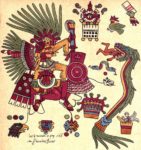 Archaeologists excavating the archaeological site of Ndachjian-Tehuacan in the central Mexican state of Puebla have unearthed the first known temple dedicated to the Aztec flayed god Xipe Tótec. The temple enclosure is 40 feet long and 11.5 feet high. Assorted architectural elements, two sacrificial altars and three sculptures carved from volcanic stone were found there: two of skinned skulls and one torso covered with the flayed skin of a sacrificial victim were found there. The temple was in use between 1000 and 1260 A.D.
Archaeologists excavating the archaeological site of Ndachjian-Tehuacan in the central Mexican state of Puebla have unearthed the first known temple dedicated to the Aztec flayed god Xipe Tótec. The temple enclosure is 40 feet long and 11.5 feet high. Assorted architectural elements, two sacrificial altars and three sculptures carved from volcanic stone were found there: two of skinned skulls and one torso covered with the flayed skin of a sacrificial victim were found there. The temple was in use between 1000 and 1260 A.D.
 Xipe Tótec, meaning “Our Lord the Flayed One” in Nahuatl, was the god of life, death, rebirth, agriculture and war. He was one of the most important deities in pre-Hispanic Mexico and he was widely worshiped throughout western and central Mexico as well as in the Gulf, but no temples directly associated with his worship had been found before now.
Xipe Tótec, meaning “Our Lord the Flayed One” in Nahuatl, was the god of life, death, rebirth, agriculture and war. He was one of the most important deities in pre-Hispanic Mexico and he was widely worshiped throughout western and central Mexico as well as in the Gulf, but no temples directly associated with his worship had been found before now.
 Images of him have survived in statues and illustrations in codices. He was depicted wearing the flayed flesh of the sacrificed, the hands dangling from his wrists. His emergence from the rotting flesh symbolized the renewal of the seasons, like a snake shedding its skin or new plants coming to life after the desolation of winter. The codices also describe the sites where people were flayed as sacrifices to Xipe Tótec. The layout of the temple and the attributes of the sculptures match the descriptions in those sources.
Images of him have survived in statues and illustrations in codices. He was depicted wearing the flayed flesh of the sacrificed, the hands dangling from his wrists. His emergence from the rotting flesh symbolized the renewal of the seasons, like a snake shedding its skin or new plants coming to life after the desolation of winter. The codices also describe the sites where people were flayed as sacrifices to Xipe Tótec. The layout of the temple and the attributes of the sculptures match the descriptions in those sources.
On one sculpture, an extra right hand hanging backwards from the left arm of the torso symbolizes the skin of the victim that was left hanging after the ritual flaying, say the archeologists.
“Sculpturally it is a very beautiful piece,” said archeologist Noemí Castillo Tejero of the National Institute of Anthropology and History in a press release. “It is around 80 centimeters tall and has a hole in the stomach that was used, according to sources, to put in a green stone and ‘bring them to life’ for the ceremonies.”
Each skull is around 70 centimeters tall and weighs about 200 kilograms.
 The important religious festival known as the Tlacaxipehualiztli, meaning “to put on the skin of the skinned one” in Nahuatl, was performed on two circular altars. One was used to sacrifice captives who first fought in gladiatoral-style combat. The other was used to skin them. The priest would then don the skin of the flayed. Because Xipe Tótec was associated with a number of diseases from acne to eye infections, worshipers would touch the flayed skin in the belief that it would cure illness. The skin was then deposited in holes. Two holes were found in the ground in front of the altars in the recently-discovered temple.
The important religious festival known as the Tlacaxipehualiztli, meaning “to put on the skin of the skinned one” in Nahuatl, was performed on two circular altars. One was used to sacrifice captives who first fought in gladiatoral-style combat. The other was used to skin them. The priest would then don the skin of the flayed. Because Xipe Tótec was associated with a number of diseases from acne to eye infections, worshipers would touch the flayed skin in the belief that it would cure illness. The skin was then deposited in holes. Two holes were found in the ground in front of the altars in the recently-discovered temple.
The sculptures have been recovered from the site and will be studied before being put on display at the Ndachjian-Tehuacán museum.